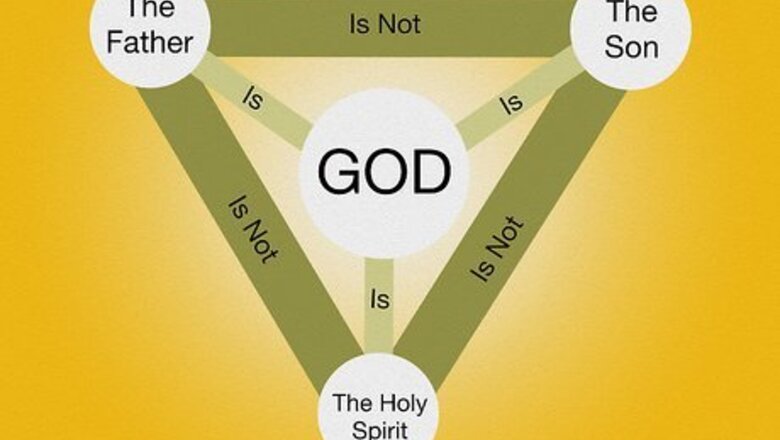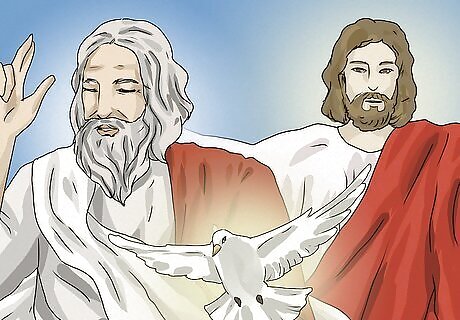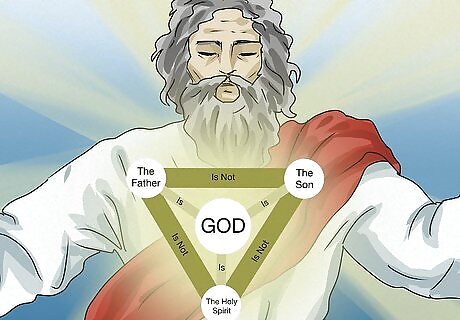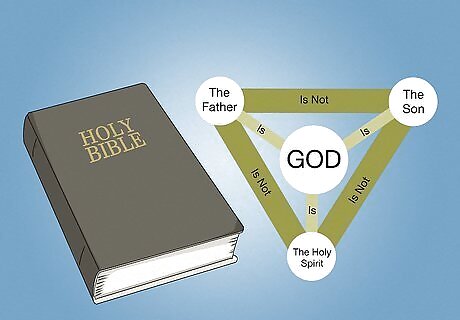
views
- The Trinity is a fundamental part of Christian belief that states that God is one essence expressed in three Persons—not selves, but more like personas.
- The members of the Trinity are all God. They all share the same attributes, and no one is more or less God than the others. The members are the Father, Son, and Holy Spirit.
- The Trinity is not the assertion that God is one and God is three. Instead, it’s a way to try to explore the mystery of God through a divine concept.
What is the Holy Trinity?

The Trinity is a Christian belief that God is 1 Being and 3 Persons. In Christianity, the being-ness that is God is expressed through the Trinity—the Father, the Son, and the Holy Spirit. The members have separate Persons, but they’re all the same Being: God, which is undivided and singular. The members of the Trinity each consider themselves “I” and the others “you,” which gives them the distinction of “Person.” In this case, “Person” doesn’t mean self, and instead refers to something more like a “persona.” The members of the Trinity recognize themselves as different from one another—they exist in different places at the same time, speak, and meet each other. For example, in Mark 1:10-11 (the baptism of Jesus) the Father speaks to the Son from heaven, and the Holy Spirit visits the scene as a dove.

The Essence of the Trinity, God, is a different kind of Being. The Trinity is three Persons constituted as one essence, God. God is expressed through the Trinity, each member of the Trinity is fully God, but they and God are not the same kind of thing. Trinity or not, God is never unformed. God is Essence, or Beingness—if it is being, it is God. In Exodus 3:13, Moses asks for God’s name, and God (in the original Hebrew) answers: Ehyeh asher ehyeh. Holy texts are almost always read in translation, which changes the affect of the message: in this case, ehyeh asher ehyeh is often translated as “I am who I am,” but the most direct translation is: “am which am.” While “I” is implied here (many languages drop subjects when they’re redundant to conjugation) it’s important to keep the affect of the original words: Ehyeh asher ehyeh doesn’t just mean “am which am,” it’s also “was which was” and “will which will.” Ehyeh asher ehyeh is a testament to God’s ever-Being, an assertion that that which is God is, was, and will be. The Trinity exists for this all-expansive God-ness to be comprehensible to humankind. If you’ve heard of YHWH (the Hebrew name of God), that comes from the third-person conjugation of the same word (ehyeh), so it’s the plural version of “being.”

Each Person is fully God, not a part, aspect, or mode of God. Essentially (no pun intended) God is one in Essence and three in Person. This means the God-ness qualities of one member are the same as the two others. There is one Being: God, and three Persons (“I”s), the Father, Son, and Holy Spirit. When theologians try to put mathematical parameters on the Trinity, the idea of “tropes” has to be thrown into the mix. Since the Son does not equal the Father, but both the Son and the Father equal God, God has to be to humanity what the members are to consciousness. Cain and Abel have separate features, but both fully and entirely are made up of humanity. Each member of the Trinity has interpersonal relationships with the others, which are sometimes seen as God’s relationships to the world at large. The Son can be seen as God through the experience of flesh, the physicality of God that walks on Earth, the Father as (creative) energy, the way in which things move and live, and the Holy Spirit as the metaphysical/spiritual/thoughtful/emotional sphere.
Misconceptions About the Trinity

The Trinity is not a “modality” of God. One misconception about the Trinity is that God plays different roles at different times. This is called “modalism.” This side steps an important aspect of the Trinity: all members exist eternally. God doesn’t just put on a different hat and become Jesus Christ, God is always all three. All three are always God.

God is not a human being. Sometimes, since the pronoun “He” is used for God, God is assumed to be a man. This can’t be true, since God encompasses (or surpasses) all things—God is beyond the limitations of any body. Trying to understand the Trinity through human terms is near impossible, since God is beyond All. God is not composed of any smaller parts (there is nothing more divisible than God) nor is God a part of a larger whole (there is nothing greater than God). God, instead, should be thought of as being “composed” by Spirit, or “divinity.”

The Trinity doesn’t violate the laws of contradiction. Being both one thing and three things can sound like a contradiction, or a statement where you both affirm and deny something. In this case, however, two types of “being” are being compared. The three all share the beingness of God, and have their own Person(a). To be a contradiction, something must be 1. quality “a” (what is a) and 2. quality anti-“a” (that which is not a). This doesn’t happen to the Trinity because the postulates are “God is 1 (in essence)” and “God is 3 (in person),” and not “God is only 1” and “God is only 3.”

The Bible never mentions “3” or the “Trinity.” In the Bible, God is never expressed through numbers, but instead through names. The passage in Matthew 28:19 distinguishes God by the three names but says “the name of [God]” instead of “the names of,” implying that God is one by three names. “Therefore go and make disciples of all nations, baptizing them in the name of the Father and of the Son and of the Holy Spirit.”
Metaphors

Using a metaphor to explain the Trinity is often misleading. If you already have a personal understanding of the Trinity, there may be a few metaphors you resonate with. Common ones are the states of matter, the sun, and an apple. All of these, however, can be confusing for new believers. These three metaphors (the Trinity as ice, water, and steam; the Trinity as a star, light, and heat; and the Trinity as the pulp, core, and skin of an apple) all relate God to the material world. The mystery of God—which the Trinity is expressing but not explaining—is beyond matter and can’t be easily understood through physical things and forms.

Thinking of the Trinity as dimensions is the most respected analogy. C. S. Lewis theorized that understanding that God is both 1 and 3 is the equivalent of a 1-dimensional being trying to conceive objects in the third dimension. This metaphor involves some math, so it can also be a little tricky. Imagine a cube. If you saw it in 1 dimension (where you can only go left or right), it would look like a line. When you add another (2D, which has left, right, up, and down) it would look like a square. And finally, when you add “forward” and “backward” in 3D, you can see it as a cube. Each dimension expresses different parts of the “cube-ness.” If you lived as a line in a world with no up or down, no back or forth, a cube would be literally outside of your realm of comprehension. You wouldn’t have had a single experience that you could relate to “cube-ness”—even if you yourself existed as a cube in higher dimensions. The Trinity, following this metaphor, are different lenses of the same thing. An object looks different in 1D than in 3D, but they’re still the same object. If God is beingness, the Trinity is a way to view the beingness—just as dimensions allow us to view beingness.

The Trinity goes beyond human terms and understanding. The infiniteness of Being (God) goes far beyond human comprehension: you may believe God is all things, the whole universe, or you may believe God is beyond all things, a separate creator. Either way, the unknowable vastness of God can make understanding this concept difficult. Because of this, don’t worry if you’re having difficulty explaining your beliefs. The actual process of understanding the Trinity—pulling back the veil of holiness—is what’s important to spiritual growth.


















Comments
0 comment